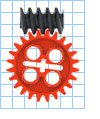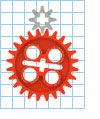|
 Example
1 Example
1
To calculate the top speed of a Rover whose's
drive train consists of a Geared 9V Technic
Motor directly
driving (1:1) a Worm gear connected to a 24t
gear. The output of the 24t gear is directly
connected
(1:1) to a Technic Motorcycle wheel and tyre
combo. What would be the estimated top speed
of this
Rover?
Gearing Ratio = 24:1
d = 82mm
r = 9.167 RPM
PI = 3.142
kph = (3.142 x 82 x 9.167)60/1,000,000
= 0.142 kilometers per
hour
mpm = (3.142 x 82 x 9.167)/1,000
= 2.361 meters a minute
mps = (3.142 x 82 x 9.167)/60,000
= 0.039 meters a second
 Example
2 Example
2
As above, except our Motor is driving an 8t gear
instead of a Worm gear. Lets assume the wheel
does
not change.What would be the new estimated top
speed?
Gearing Ratio = 3:1
d = 82mm
r = 73.333 RPM
PI = 3.142
kph = (3.142 x 82 x 73.333)60/1,000,000
= 1.134 kilometers per hour
mpm = (3.142 x 82 x 73.333)/1,000
= 18.893 meters a minute
mps = (3.142 x 82 x 73.333)/60,000
= 0.315 meters a second
|







